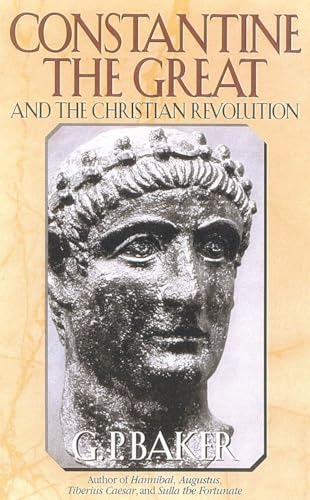Hey there, history buffs and bored people just looking for something to read! Today I’m reviewing Constantine the Great. If you’ve ever wondered how one guy could go from dodging arrows to bossing around an entire empire (and maybe picking fights with his own family), this book spills the beans. Get ready for some big battles, wild religious shake-ups, and enough drama to make your group chat look tame. I’ll tell you what works, what stumbles, and whether you should fork over your lunch money for it.
Review: Constantine the Great
In a nutsheel
“Constantine the Great” is a history book that takes you back to the days when emperors wore sandals and lions were not in zoos. The author, who clearly loves Roman history more than pizza, gives a look at the life and wild times of Constantine, the first Christian emperor. You get plenty of battles, power plays, and a slice of religious drama. There’s also a big helping of themes like loyalty, faith, and making choices that change the world. If you like stories that mix action with big questions, but don’t want spoilers, this book will keep you hooked from start to finish.
How Constantine the Great Climbed the Ladder: From Soldier to Emperor
Let me tell you, if there was ever an underdog story in ancient Rome worth reading about, it’s Constantine the Great’s rise. This guy did not just wake up as emperor one morning. No, no—his path was full of speed bumps, power-hungry rivals, and a parade of unpredictable Romans.
Constantine started as a regular ol’ officer, working for his dad, Constantius. And let me just say, being the son of a Caesar sounds great… until you remember that ancient Romans handed out the title ‘Caesar’ like my grandma gives out Christmas cookies—often and to everyone. After his dad died, Constantine found himself in a high-stakes game of musical chairs, but with swords instead of chairs. He wasn’t even in Rome when he was declared emperor by his troops in York (of all places—hello, rainy England!).
Next, he had to deal with a whole line-up of wanna-be emperors. Maxentius, being the worst of the group, decided to make it personal. Cue the famous Battle of Milvian Bridge. Now, I thought my friends wrestling over the remote was dramatic, but Constantine’s army charged across a river, banners waving, and squashed Maxentius in a flash. It’s like Game of Thrones with less dragons and more togas.
Of course, getting the purple cloak was only the start. Constantine had bigger things in mind. He soon turned his eyes to faith and how it could shape an empire. Next up: we tackle his religious transformation and the impact it had on the world—prepare your holy socks!
Constantine the Great: Shaping Faith and Changing an Empire
Let’s talk religion. Not the kind where your aunt corners you at Thanksgiving, but the kind that flips an empire on its head. Constantine the Great wasn’t just an emperor with a catchy name. He’s the guy who set Christianity on the path from weird cult to front-row seats at the Roman Empire’s main show. And trust me, this was no easy Sunday stroll to the church.
When he became emperor, Christianity was about as popular as my homemade spaghetti at a gluten-free potluck. Christians were often in hiding, hoping not to get tossed to lions or roasted at parties (seriously, the Romans were wild). But Constantine? He steps up, declares his support for Christianity, and suddenly, being Christian was less “underground rave” and more “everyone’s invited.” Most folks know about the Edict of Milan, where he made it okay to believe in Jesus without worrying about being tomorrow’s lunch special.
But Constantine wasn’t just ticking the ‘Christian’ box on his census form. He funded church buildings, gathered religious leaders at the Council of Nicaea (where they hashed out church stuff and probably argued over the best wine), and mixed his face with religious art. Even his coins winked at Christian symbols. Still, he didn’t ban old Roman gods outright. He was more like, “Hey, worship who you want, but have you tried this new church?”
Of course, not everyone was thrilled. Some pagans grumbled, some Christians were suspicious that it was all a ruse, and a few party poopers just missed the old ways. Either way, Constantine’s religious moves changed the game for Europe, shaping what church and politics would look like for centuries.
But let’s not forget—faith wasn’t the only thing Constantine shook up. Now, buckle in as we march into his wild and woolly military campaigns and strategies!
Constantine the Great’s Military Campaigns and Battle Tactics
If you think army life is all bad food and marching, Constantine the Great would like a word. This guy knew his way around a battlefield. When I read about his campaigns, it felt a bit like playing Risk—except with more capes and less arguing with your cousin over who gets Australia. Constantine’s military journey started in earnest after the death of his father, Constantius, when the troops in York (yes, British York!) declared him emperor. Bold move by the local lads, but it worked out.
One thing I noticed is that Constantine was a king of strategy. At the Battle of Milvian Bridge, he faced Maxentius, his big rival. Despite being outnumbered, Constantine used smart tactics. He chose the grounds by the river so Maxentius’s men were stuck. Spoiler: Maxentius ended up going for a little swim he didn’t survive. Constantine also reformed the army. He made cavalry more important and used mobile troops. This was like switching from horses to motorcycles in Mario Kart. You just zip around everyone else.
I’ll be honest, Constantine wasn’t perfect. Some say he was a bit ruthless—he could be quick to chop heads when people got in his way. But in war, this kept people from trying funny business. Overall, his battle skills made him emperor of everyone from Spain to Syria. Next up, I’ll tell you about his personal life and leadership style—there’s less sword fighting, but just as much drama!
Constantine the Great: The Man Behind the Armor
Let’s put the swords and shields away for a second and peek into the softer, or at least slipper-wearing side, of Constantine the Great. Now, you might think, “Steve, what was this guy like at home? Did he even own slippers?” Good question! History isn’t crystal clear on the footwear, but it does show that Constantine wasn’t just a battlefield whiz. The dude had a whole family drama going on.
Constantine juggled being a family man and a ruler like someone trying to cook and answer the door at the same time. He appointed his sons as co-emperors, which sounds nice until they started backstabbing each other after his death. Still, he paved the way for dynastic rule. His mother, Helena, was a big influence too, getting him to check out some holy sites and kickstarting future pilgrimages. He built lots of shiny buildings, not just for God but for his loved ones, too.
Leadership style? Constantine didn’t really go for the “let’s vote on it” method. He liked making up his mind and letting everyone else know about it, pronto. He was clever, though, and knew how to keep people on his side—unless you were one of the people he didn’t want on his side, in which case you might want to keep your running shoes handy.
Do I recommend reading about Constantine’s personal life and leadership style? Absolutely! It’s messy, it’s wild, and you might even feel better about your own family squabbles. I say grab this book if you like history with a side of juicy drama.
Conclusion
Well folks, that wraps up my review of Constantine the Great. This book took me on a wild ride through ancient Rome, with power grabs, wild battles, and family drama that made my own family look normal. The author does a good job mixing facts with fun stories, though sometimes the names get confusing (honestly, everyone is either named Constantine or some version of Maximus). If you like history with a little bit of sass and a lot of action, this one is worth a read. Just bring a strong cup of coffee for the dense bits. Thanks for sticking with me to the end!


